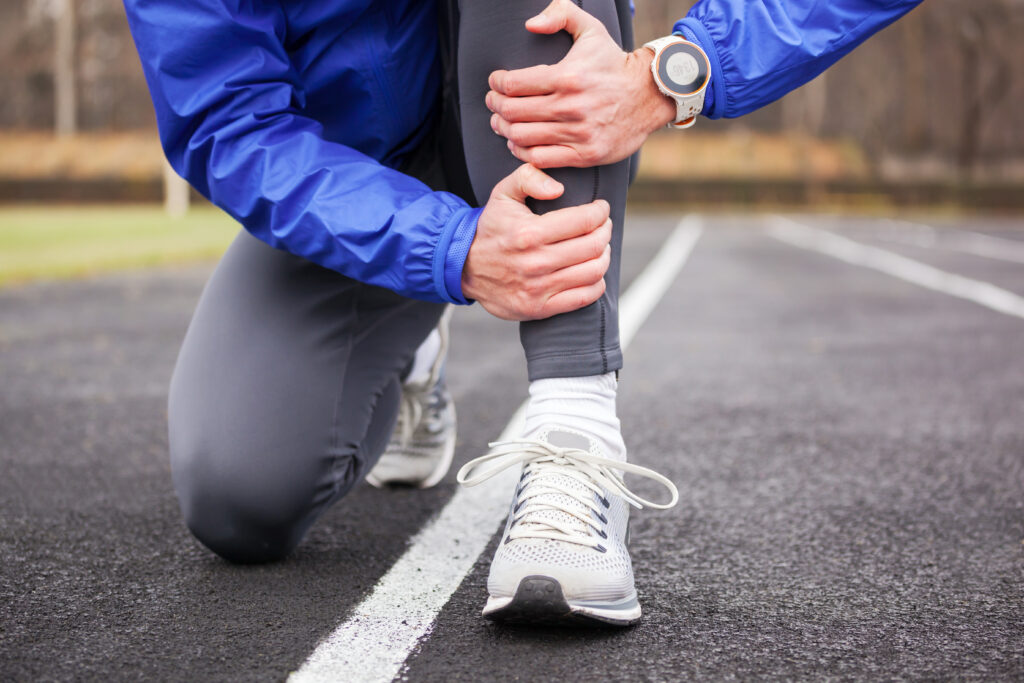By Andrea Mulligan, DPT, physical therapy

Anyone whose activities put their shinbones through repeated pounding, especially on hard surfaces — sorry to all you runners out there — is at risk of shin splints. This common stress injury announces itself as pain along the front of the tibia — the lower leg bone that we call the shin. While the pain may be relieved with rest, it comes right back during activity.
Shin splints — also known as medial tibial stress syndrome (MTSS) — can sideline you from your activity for several weeks. Knowing how to prevent them, and what to do if they start up, can help you stay in your game.
Who tends to get shin splints?
In addition to runners and track athletes, shin splints are common among dancers, with their repetitive jumping on hard floors, and in military recruits going through basic training. Anytime you change your exercise routine from low-impact to higher-impact activities, or significantly increase the intensity, frequency or duration of your training, you run the risk of shin splints.
Other risk factors that increase the likelihood of shin splints include:
- Foot pronation or arch instability
- Higher body mass index
- Being a woman
- Having osteoporosis
What should you do if you think you have shin splints?
- rest the affected leg(s). Take a break until you can return to your sport with no pain, or only very, very low-level pain. That typically takes a week or two, but it can take longer for high-impact activities.
- Switch to lower-impact activities for a while. If you can do a lower-impact exercise that’s not painful — such as elliptical training, cycling or swimming — keep that up to maintain your strength, conditioning and mobility.
- Go shoe shopping. If your shoes are super worn down, it might be time to invest in a new pair. And don’t just grab the same shoes you always get. Things change. Maybe your shoes should, too. See the preventive tips below.
- Try RICE. Rest (see above), ice, compression and elevation — along with anti-inflammatories if they’re safe for you —can help in the acute phase.
How long does it take to recover from shin splints?
With good self-care, the typical tissue-healing time frame is 6-8 weeks. However, it often takes longer to return fully to your prior exercise levels. When returning to high-impact sports, start slowly and build gradually.
When should you see a health care provider?
If you’re having a hard time returning to your sport, a physical therapist can help you find the right exercises and guide you through the recovery process safely. We also can help you understand biomechanics and proper form to prevent a recurrence. If you have significant swelling, redness, heat, or constant pain even at rest, please reach out to your primary care team. It’s important to rule out a potential stress fracture or compartment syndrome in the lower leg.
The two keys to preventing shin splints
Pay attention to your shoes. If they’re really old or provide poor arch support, they could put you at risk of shin splints. I strongly recommend skipping the internet shopping and visiting a shoe store, where you can try on different options and ask questions. Pay attention to:
- The toe box: Make sure the shoes don’t squish your toes.
- Drop height: Avoid making big changes in drop height (the difference in height from the heel to the toe). If you’ve been wearing shoes with a zero drop for years, don’t suddenly change to a 14 mm drop.
- Cushion: Look for shoes with more cushion to help reduce impact. Even if you like a zero drop, you still can find shoes with a lot of cushion.
Consider modifying your activities. If you have a history of shin splints and are worried about recurrence, take a look at your training program or goals. Are you jumping in too fast, too hard or too soon? Consider:
- Varying your route: If you only train on concrete, can you add some variety by running on trails, turf or rubber tracks? A change in surfaces can help prevent injuries.
- Varying your activities: Do you only run, or only dance? Consider adding some cross training and/or strength training to support your preferred sport.
Don’t give up on being active!
Shin splints are repetitive overuse injuries, so resting from the high-impact sport that caused the problem is vital. But that doesn’t mean you have to sit on the couch until the pain is gone. It’s OK to continue low-impact activities to maintain your strength and sanity until you can return to your sport. If you’re stuck, come on over and see your health care team. We can help!


